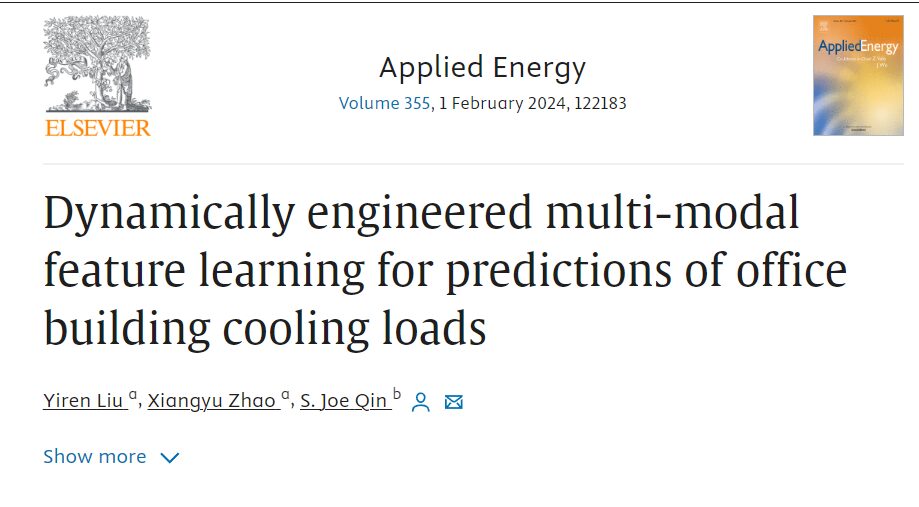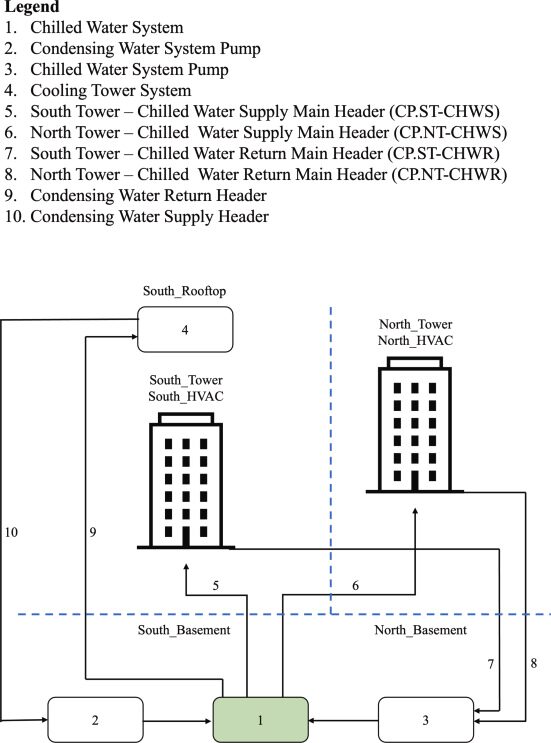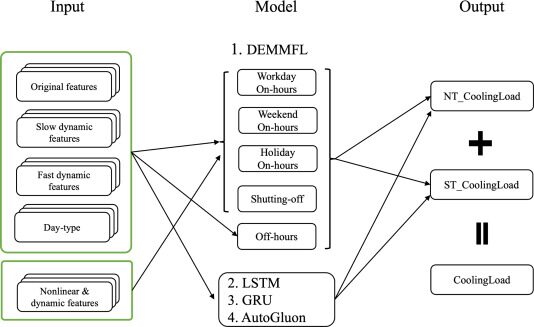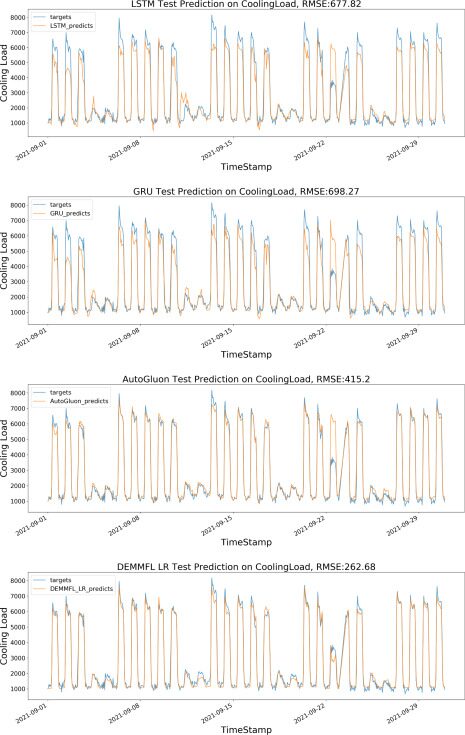AI 赋能绿色制冷,香港岭南大学开发 DEMMFL 模型进行建筑冷负荷预测

近年来,城市化进程加速所带来的碳排放量骤增,已经严重威胁到了全球环境。多个国家均已给出了「碳达峰,碳中和」的明确时间点,一场覆盖全球、全行业的「绿色革命」已经拉开序幕。在一众行业中,建筑是当之无愧的能耗大户,其中又以暖通空调 (Heating, ventilation, and air-conditioning, HVAC) 系统为「重灾区」。相关数据显示,供暖、通风和空调 (HVAC) 占全球建筑物能源消耗的 38% 。
针对居高不下的建筑能耗,业内往往通过优化设备运行效率,以及智能控制来实时调控能耗。其中,针对冷水机组运行控制方面,冷负荷预测是优化冷水机组排序控制的重要途径,其能够忽略冷负荷的临时变化,避免不必要地开关暖通空调设备和冷水机组,从而减少由于启停引起的消耗。
此外,不同地区的气候条件不同,导致其在 HVAC 方面的消耗亦有所不同,例如香港处于热带气候条件,HVAC 的能耗占比更高。在香港特别行政区机电工程署举办的「建造机电设施的全球人工智能挑战」中,来自香港岭南大学和香港城市大学的研究人员,提出了一种新的动态工程化多模态特征学习 (DEMMFL, dynamically engineered multi-modal feature learning) 模型,用于长期准确预测建筑冷负荷,从而达到节能的目标。

获取论文:
https://www.sciencedirect.com/science/article/pii/S0306261923015477
后台回复「冷负荷」获取完整论文 PDF
数据集:两栋办公楼的冷负荷数据
在本研究中,研究人员聚焦于香港两座办公大楼 (South_Tower 和 North_Tower,ST&NT) 的建筑能耗问题,建立了一个详细的数据集,涵盖了 2020 年 4 月 1 日至 2021 年 9 月 30 日的时间范围。该数据集通过每 15 分钟的采样间隔收集数据,确保了对建筑能耗动态的细致捕捉。

模型架构:DEMMFL 模型
如下图所示,为了预测建筑冷负荷,将收集到的数据特征输入 DEMMFL 模型和 Deep Learning 模型,输出 ST 和 NT 共同的冷负荷数据。

在本研究中,研究团队开发了一种称为 DEMMFL(动态工程化多模态特征学习)的预测模型,专门用于预测建筑冷负荷。该模型结构是在没有自回归输出项的情况下,利用过去输入数据的卷积构建的。
为了实现长期预测的准确性,DEMMFL 模型采用正则化的统计学习方法以实现预测的最佳方差和偏差权衡。研究中使用了 Lasso 、 ridge 以及最近开发的 Lasso-ridge 回归,通过交叉验证(CV)来优化学习超参数。通过这种方法,研究团队能够对包括冷负荷在内的所有特征和数据进行有效的缩放和处理,从而提升模型的准确性和效率。
此外,本研究还探索了多种深度学习模型,包括通过 AutoGluon 实现的 XGBoost 和 LightBoost,以及 LSTM 和 GRU 。所有这些模型的训练方法均采用平均平方误差作为损失函数,训练方法为 ADAM 。
整体性能最好:Lasso-ridge 回归
研究人员对比了 DEMMFL 模型在训练集和测试集上的统计学习性能,结果显示,Lasso-ridge 在除非运营时段外的所有模式中均优于其他三种技术,并且在测试集上的整体性能比排名第二的方法提高了 4.2% 。

这一结果表明,在利用 Lasso-ridge 方法时,DEMMFL 模型在建筑冷负荷的长期预测方面表现出色,不仅在精度上有显著提升,而且在变量选择上更为高效,这为建筑能耗管理提供了一个有效的工具。
预测敏感性:冷负荷与 OAT
在对 NT 和 ST 的工作日运营时段模式进行分析时,研究人员发现 OAT(室外气温)特征在冷负荷预测中起着主导作用。
建立模型后,研究团队对每个模型中冷负荷相对于 OAT 的敏感性进行了评估。在保持其余变量不变的情况下,他们将 OAT 增加一摄氏度,并相应地计算其他与 OAT 相关的变量。

实验结果表明,不同建筑的冷负荷对 OAT 的敏感性存在显著差异。南塔由于其较大的规模,其冷负荷对 OAT 的变化更为敏感。此外,除了在运营时段模式外,两座塔楼的敏感性差异在其他所有模式中都有所增加,这可能与建筑的不同特性和运营模式有关。
DEMMFL 模型:高精度、低误差
研究人员使用 LSTM 、 GRU 和 AutoGluon 等深度学习模型对同一训练数据集进行了优化,并在 2021 年 9 月的同一测试集上与 DEMMFL 模型进行比较。由于采用了知识驱动的工程化特征,DEMMFL 模型展现出了明显的优势,实现了最佳的 RMSE,而 AutoGluon 模型取得了次优。

比较实际与四个模型预测的冷负荷数据,结果如下图。

LSTM 和 GRU 在月初的前三天显示出明显较差的预测结果,在 9 月 22 日(中秋节假期)时,深度学习模型出现了很大的预测误差,而 DEMMFL 模型则预测得非常准确。
综上,DEMMFL 模型在预测建筑冷负荷方面预测精度更高,误差更小。
从能源管理出发:AI 与城市建设的未来
利用 DEMMFL 模型,无论是商业大厦、住宅区还是公共设施,都能够实现准确的能耗预测与优化,这一技术的扩展将帮助我们更好地理解和管理城市建筑群的整体能耗,从而促进更高效、更可持续的城市发展。
关乎全球环境,降碳降耗需要每个家庭、每个企业、每个行业共同努力。近年来,快速增长的能耗优化需求也催生一批成熟解决方案,并在落地中持续迭代。 IBM 、谷歌 DeepMind 、施耐德电气,以及国内的商汤科技、美的楼宇科技等企业均利用人工智能协助能源管理。
例如,谷歌 DeepMind 将机器学习算法应用于美国中部地区 700 兆瓦的风电场,基于神经网络,利用广泛可用的天气预报和历史涡轮机数据进行训练,在实际发电前 36 小时,预测风力输出,从而提前一天建议工作人员基于每小时交付多少电力,制定更加准确的能源供应计划。
商汤科技基于其大装置 SenseCore 和商汤日日新 SenseNova 大模型体系强大的架构底座,持续输出高质量的 AI 算法和算力赋能电力系统多域智能化升级。
美的楼宇科技结合 AI 技术与暖通领域专家经验,开发了一款面向暖通空调系统运行优化的算法引擎 Smart Control,可以精准匹配冷热需求,结合 iBUILDING 云平台,可以实现节能减碳 15%-30% 、舒适性提升 30% 以上的优化效果。
在未来,AI 技术将与城市规划和管理紧密结合,打造一个高度集成、智能互联的生态系统,在其中 AI 扮演的角色不仅是技术的应用者,更是城市发展的引领者。
随着 AI 技术的不断发展,我们期待着一个更加高效、可持续和包容的城市未来。
参考文献:
https://www.sciencedirect.com/science/article/pii/S0306261923015477?via%3Dihub
https://www.marketsandmarkets.com/industry-news/AI-Powered-Energy-Sector-in-2023-Products-Companies-and-Innovations
https://tech.chinadaily.com.cn/a/202308/04/WS64ccbca7a3109d7585e47fbf.html